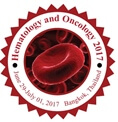
Ashok Vaid
Medanta Cancer Institute,India
Title: A study of the Clinico-pathological features, prognostic features and treatment outcomes among Indian patients with diffuse large B-cell lymphoma - A single center experience
Biography
Biography: Ashok Vaid
Abstract
Background:Diffuse Large B cell Lymphoma (DLBCL) accounts for approximately 25% of all Non-Hodgkin’s lymphoma (NHL) in the developed world, making it the most common lymphoma. With the diversities in clinical presentation, morphology, molecular and genetic alterations, DLBCL represents a heterogeneous group rather than a single disease entity. Based on the cell-of-origin (COO) concept, gene expression profiling (GEP) has identified two major subtypes of DLBCL with differing prognoses. We aim to study the trends in the clinico-pathological features, prognostic factors and treatment outcomes following standard therapy in Indian population at tertiary care center.
Methods:A prospective study was conducted and all newly diagnosed patients of DLBCL between September 2009 and April 2016 were included. The clinico-pathological features, IPI score, extranodal involvement and stage of disease were recorded using a proforma. All patients received Rituximab based treatment which was modified according to their tolerability. Immunohistochemistry was performed for molecular subtyping.
Results:We included 189 consecutively diagnosed cases of DLBCL in the study. 52% (n=99) patients were > 60 years and 48% (n=90) < 60 years, the median age being 55 years. Majority were men (63%; n=119) versus women (37%; n=70). Fever (28%), pain abdomen (21%) and painless neck swelling (17%) were the most common presenting symptoms. SVC syndrome and bulky disease were noted in 12 (6.3%) and 10 (5.3%) of patients. 65% (n=123) had nodal predominant disease versus 35% (n=66) with extranodal disease; stomach (12.2%) and skeletal disease (6.3%) being the most common extranodal site. IPI score distribution was as follows: 28% (n=55) with low, 24.5% low intermediate, 22.2% high intermediate and 25.4% with high IPI score. Bone marrow involvement was detected in 20.1% (n=38) by bone marrow biopsy and 13.2% (n=25) by PET CT whole body scan. Stage IV disease was diagnosed in 52% (n=98), 21.2%, stage III 16.9% stage II and 10.1% in stage I. 89.4% were treated with R-CHOP with 92% receiving 6 cycles of chemotherapy. 68.4% achieved complete metabolic response (CMR), 22.7% (n=43) partial response (PR), 1.5% (n=3) progressive disease and 2.1% (n=4) died before completion of chemotherapy course. Better CMR rates were observed in patients < 60 years versus > 60 patients (75.5% {68 out of 90} v/s 53.5% {53 out of 99}; p=0.026). Molecular subtyping was performed in 116 patients with GCB subtype seen in 55.2% (n=64) and ABC in 44.8% (n=52). The CMR rates were seen in 71% (37 of 52 patients) of GCB subtype and 65% (42 out of 22 patients) of ABC subtype (p=0.65).
Conclusions: R-CHOP remains the standard of care for patients with DLBCL. However, literature reports a cure rate of only 60% with standard immuno-chemotherapy cures with 40% eventually dying of the relapsed disease. DLBCL can no longer be considered and treated as one disease. Efforts are in way to improve the standard of care and identify a new biological agent (X) to add on to the R CHOP backbone. It is also imperative to identify those prognostic markers that would identify subset of patients who would benefit from a more aggressive course.

